Adapters for Olympus BX and IX Microscopes
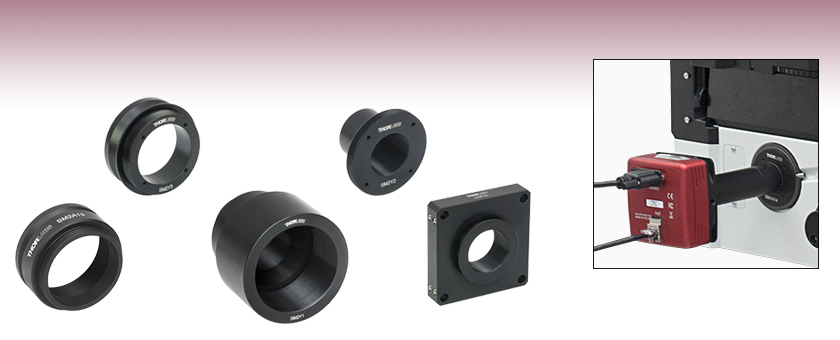
- Adapters for Epi-Fluorescence, Transmitted Illumination, Camera, Trinocular, Eyepiece, and Condenser Ports, as well as Trinoculars
- Modify Olympus BX and IX Microscopes Using Thorlabs'
Optomechanical Components
SM2Y3
Condenser Port Adapter
SM2A13
Transmitted Illumination Port Adapter
SM2Y1
Epi-Fluorescence Port Adapter
The SM1A51 Camera Port Adapter Used to Mount a Scientific-Grade CCD Camera on an Olympus IX Microscope
LCPY2
Trinocular Port Adapter
SM2Y2
Eyepiece Adapter

Please Wait
Click on Each Port to View Available Adapters

Figure 1.1 Olympus IX71 Microscope
Features
- Extends Versatility of Thorlabs' Construction Systems to Olympus BX and IX Microscopes
- Provides Compatibility with SM1 Lens Tubes, SM2 Lens Tubes, and 30 mm and 60 mm Cage Systems
- Available for Epi-Fluorescence, Transmitted Illumination, Camera, Trinocular, Eyepiece, and Condenser Ports
- Contact Tech Support About Custom Adapters, Including Other Microscopes
Illumination Adapters
The SM2Y1 adapter allows Ø2" and Ø30 mm optics to be mounted inside an Olympus IX71 epi-fluorescence port, as well as externally SM2-threaded components. When used along with the LCP11(/M) adapter, the epi-fluorescence port also becomes 60 mm cage compatible, enabling the connection of various illumination sources, such as infrared (IR) and white LEDs, as well as complex light conditioning assemblies.
Thorlabs also offers multiple adapters for Olympus BX41, BX51, IX71, IX73, IX81 or IX83 transmitted illumination ports. These adapters provide rigid coupling to maintain long-term, stable alignment for the connection of laser beam combiners, LED light sources, and other mechanical and optical components.
Camera Port Adapter
The SM1A51 adapter is designed to allow SM1-threaded and 30 mm cage system components to be mounted to the camera port on an Olympus BX or IX microscope. This adapter is ideal for inserting custom optics, as well as our scientific CMOS cameras, into a microscope system.
Trinocular Port Adapter
The LCPY2 adapter is designed to connect custom widefield viewing and image detection setups to the trinocular port of an Olympus BX or IX microscope.
Trinocular Adapters
Olympus trinoculars can be integrated into DIY Cerna, Upright Nikon Eclipse, Nikon Eclipse Ti, or Nikon Eclipse Ti2 microscopes using the LCPN3 or LCPY3 adapters.
Eyepiece Adapter
The SM2Y2 adapter replaces the lens element on an eyepiece of the microscope trinoculars, allowing custom image detection or viewing setups to be attached to the microscope.
Condenser Port Adapter
The SM2Y3 adapter connects a custom light conditioning assembly to the condenser holder of an Olympus BX or IX microscope.
Note: Thorlabs does not guarantee compatibility with other industry-standard microscopes not explicitly mentioned on this webpage.
| Adapters for Industry Standard Microscopes |
|---|
| Cerna DIY Series |
| Leica DMI |
| Nikon Eclipse Ti (Inverted) |
| Nikon Eclipse Ti2 (Inverted) |
| Upright Nikon Eclipse |
| Olympus BX and IX |
| Zeiss Axioskop and Examiner |
| Table 76C Thorlabs Dovetail Referencea | |||
|---|---|---|---|
| Type | Shape | Outer Dimension | Angle |
| 95 mm | Linear | 95 mm | 45° |
| D1N | Circular | Ø2.018" | 60° |
| D2Nb | Circular | Ø1.50" | 90° |
| D2NBb | Circular | Ø1.50" | 90° |
| D3N | Circular | Ø45 mm | 70° |
| D5N | Circular | Ø1.58" | 90° |
| D6N | Circular | Ø1.90" | 90° |
| D7N | Circular | Ø2.05" | 90° |
| D8N | Circular | Ø40 mm | 90° |
| D9N | Circular | Ø50 mm | 90° |
| D10N | Circular | Ø52 mm | 90° |
| D1T | Circular | Ø1.50" | 60° |
| D3T | Circular | Ø1.65" | 90° |
| D4T | Circular | Ø1.20" | 90° |
| D1Y | Circular | Ø107 mm | 60° |
| D2Y | Circular | Ø2.32" | 50° |
| D3Y | Circular | Ø1.75" | 90° |
| D4Y | Circular | Ø56 mm | 60° |
| D5Y | Circular | Ø46 mm | 60° |
| D6Y | Circular | Ø41.9 mm | 45° |
| D1Z | Circular | Ø54 mm | 60° |
| D2Z | Circular | Ø57 mm | 60° |
| D3Z | Circular | Ø54 mm | 45° |

Click to Enlarge
Figure 76B This photo shows the male D1N dovetail on the trinoculars next to the female D1N dovetail on the epi-illumination arm.
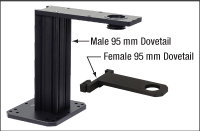
Click to Enlarge
Figure 76A This photo shows the male 95 mm dovetail on the microscope body and the female 95 mm dovetail on the CSA1002 Fixed Arm.
Introduction to Microscope Dovetails
Dovetails are used for mechanical mating and optical port alignment of microscope components. Components are connected by inserting one dovetail into another, then tightening one or more locking setscrews on the female dovetail. Dovetails come in two shapes: linear and circular. Linear dovetails allow the mating components to slide before being locked down, providing flexible positioning options while limiting unneeded degrees of freedom. Circular dovetails align optical ports on different components, maintaining a single optical axis with minimal user intervention.
Thorlabs manufactures many components which use dovetails to mate with our own components or those of other manufacturers. To make it easier to identify dovetail compatibility, we have developed a set of dovetail designations. The naming convention of these designations is used only by Thorlabs and not other microscope manufacturers. Table 76C lists all the dovetails Thorlabs makes, along with their key dimensions.
In the case of Thorlabs’ Cerna® microscopes, different dovetail types are used on different sections of the microscope to ensure that only compatible components can be mated. For example, our WFA2002 Epi-Illuminator Module has a male D1N dovetail that mates with the female D1N dovetail on the microscope body's epi-illumination arm, while the CSS2001 XY Microscopy Stage has a female D1Y dovetail that mates with the male D1Y dovetail on the CSA1051 Mounting Arm.
To learn which dovetail type(s) are on a particular component, consult its mechanical drawing, available by clicking on the red Docs icon (![]() ) below. For adapters with a female dovetail, the drawing also indicates the size of the hex key needed for the locking setscrew(s). It is important to note that mechanical compatibility does not ensure optical compatibility. Information on optical compatibility is available from Thorlabs' web presentations.
) below. For adapters with a female dovetail, the drawing also indicates the size of the hex key needed for the locking setscrew(s). It is important to note that mechanical compatibility does not ensure optical compatibility. Information on optical compatibility is available from Thorlabs' web presentations.
For customers interested in machining their own dovetails, Table 76C gives the outer diameter and angle (as defined by Figures 76D and 76E) of each Thorlabs dovetail designation. However, the dovetail's height must be determined by the user, and for circular dovetails, the user must also determine the inner diameter and bore diameter. These quantities can vary for dovetails of the same type. One can use the intended mating part to verify compatibility.
In order to reduce wear and simplify connections, dovetails are often machined with chamfers, recesses, and other mechanical features. Some examples of these variations are shown by Figures 76D and 76E.

Click to Enlarge
Figure 76D Two examples of how circular male dovetails can be manufactured.

Click to Enlarge
Figure 76E Two examples of how circular female dovetails can be manufactured.
| Posted Comments: | |
Robert Hochhalter
(posted 2025-01-14 19:11:00.46) I'm not clear on the purpose of the rings. cdolbashian
(posted 2025-01-29 10:08:35.0) Thank you for reaching out to us with this comment. The rings of interest here are 'retaining rings'. They are used to secure unthreaded 1" optics within a threaded optical tube, such as the one featured in the center of the SM2Y2. I have reached out to you directly to discuss this further. Andy M
(posted 2024-07-11 11:09:21.72) Are any of these adapters compatible with the epifluorescence illumination port of the BX51 microscope? We would like to build a coupler to introduce 2 light sources into our microscope based on 60 mm cage parts: For example, mounting a 60 mm cube beam-turning mirror to select between a lamp and a tunable LED light engine. cdolbashian
(posted 2024-07-19 04:29:02.0) Thank you for reaching out to us with this inquiry. We have have a variety of adapters compatible with the BX51 shown above on this page. I have contacted you directly in order to determine if we carry one which would be compatible with the epi-illumination port of your BX51 specifically. Tao Yang
(posted 2023-05-16 22:09:57.343) Could you please have a replacement for SM2Y1 that works for IX73? IX 71 is pretty old now. jdelia
(posted 2023-05-18 01:09:43.0) Thank you for contacting Thorlabs and for providing this valuable feedback. While this unfortunately is not something we currently offer, I could certainly pass along your request to our design engineers via our internal suggestion forum for consideration as a future product. Louis Hodgson
(posted 2022-10-03 15:36:22.107) I wish the threaded 4-40 holes (x4) are through holes (all the way through). What if I want to mount the cage system from the other side? Right now, only one orientation possible. Just this simple modification will make things so much more versatile. mdiekmann
(posted 2022-10-05 10:43:03.0) Thank you for your feedback. We shared it with our R&D team who will consider your suggestion. JIAZE YIN
(posted 2022-02-04 23:43:40.883) The backport adapter for IX71 is no longer suitable for ix73. Will this adapter be continued for new microscope frame? jgreschler
(posted 2022-02-17 03:46:52.0) Thank you for reaching out to Thorlabs. Our product line is always evolving to keep up with the current trends in microscopy applications. I have made a post on our company product development forum to reflect this feedback. Mark Ziffer
(posted 2021-12-04 14:08:24.97) Hello,
I was wondering if this component is also compatible with the Olympus IX73, or if it is only the IX71? Thanks
Mark YLohia
(posted 2021-12-06 01:44:32.0) Hello Mark, thank you for contacting Thorlabs. Unfortunately, the SM2Y1 is not compatible with the IX73. Craig Prater
(posted 2020-10-30 19:21:41.897) Hi. Just wanted to mention that you have a small error in the Solid Works model for this part that makes it hard to use in CAD assemblies. This part is supposed to be compatible with 30 mm cage mount system, but the center to center distance for the 30 mm rod pattern in the model is 29.997 mm. That means that when I try to put it into an assembly in Solid Works and line up the 30 mm cage rods with the mounting holes, Solid Works fill not allow the mate alignment steps to complete. I understand this is a very small discrepancy, but it is making it such that I can't complete my design using this part without doing some complicated workaround. llamb
(posted 2020-11-06 09:16:46.0) Thank you for your feedback. We will look to correct this error in the Solidworks model of the SM1A51. Valentin Stein
(posted 2020-08-12 05:21:10.263) I suggest to offer the counter parts for the dovetail adaptors (not only Olympus, but also Nikon and Zeiss) to connect lamp housings to custom build systems.
Best,
Valentin wskopalik
(posted 2020-08-13 11:09:02.0) Thank you for your feedback!
We will definitely consider your suggestion. For custom systems there might however also be other solutions which would be more versatile and do not require these microscope- and brand-specific adapters.
I will contact you directly to provide further assistance. daw
(posted 2018-06-22 11:53:04.9) It would be great to be able to buy the reverse of this part, i.e., an adapter from SM1 to female D5Y dovetail, so I could put together custom intermediate optics in my Olympus system. YLohia
(posted 2018-06-22 03:13:16.0) Hello, thank you for your valuable feedback. I have posted this idea on our internal engineering forum. nataliao
(posted 2014-04-04 14:37:48.793) It would be great to be able to purchase an adaptor for Leica microscopes camera port. Namely, DM6000 scope. We would buy at least 10 of them as to how often that would be used. besembeson
(posted 2014-04-10 02:07:03.0) Response from Bweh E at Thorlabs: Thanks for choosing Thorlabs. I will contact you via email to establish your requirements so that we can provide this to you as a special. This is a good idea and we will look into making this a regular stock item. tcohen
(posted 2012-07-05 15:14:00.0) Response from Tim at Thorlabs: Thank you for your feedback. We strive to provide the best products at the best possible pricing. That being said, these products are more costly to produce than our other adapters. Pricing and performance are two areas we are always trying to improve upon and we will revisit these prices to ensure they are priced fairly according to their manufacturing costs and value. We are glad you find them useful and we appreciate your time in submitting your feedback so that we can continue to improve the value of these products. daw
(posted 2012-06-27 08:39:45.0) These are useful products, but they are terribly overpriced. They really ought to be priced similarly to your other lens tube adapters (at http://www.thorlabs.us/NewGroupPage9.cfm?ObjectGroup_ID=1524). jjurado
(posted 2011-08-09 19:32:00.0) Response from Javier at Thorlabs to nizamov.shawkat: Thank you very much for your feedback. We will look into the feasibility of offering such adapter. I will contact you directly for further discussion. nizamov.shawkat
(posted 2011-08-09 18:03:33.0) Its a pity that Thorlabs does not offer an 23.2 microscope eyepiece adapter. For instance, microscope eyepiece may be used (internal 23.2 - external/internal SM1) or custom device may be inserted instead of the the eyepiece (external 23.2 - external/internal SM1). Best would be something like int.23/ext. SM1 - ext 23.2 - it is a single adapter that fits both use cases. Some other companies sell eyepiece adapters for c-mount, so there is a demand for such adapters. Ill use such adapter. Adam
(posted 2010-05-07 11:36:22.0) A response from Adam at Thorlabs to halvorsen: I would like to find out the type of microscope you have. The Nikon adapter we sell is designed for the Nikon Eclipse Microscope. There is another Nikon Microscope called the Ti, which does require springs for mounting adapters on the unit. We are working on a prototype unit for release as a new product. In the meantime, we can offer this as a custom unit. I will contact you directly to see if you are interested. halvorsen
(posted 2010-05-07 09:56:03.0) The Nikon adapters do not mount as solidly as actual Nikon products - there is definitely some wiggle room. This is disappointing and makes these adapters not that useful for microscopy requiring precision illumination (e.g. using a laser). Thorlabs needs to add the little leaf springs to each of the 3 tabs to make this a more useful product. For now, I guess Ill have to machine it myself. klee
(posted 2009-07-29 11:06:01.0) Response from Ken at Thorlabs to wwarger : Unfortunately, we do not have the interface details for the Olympus U-DP and Trinocular so designing an SM1 adapter to fit them would be impossible. However, if you can provide these details then we could look into it with more certainity and come back with a proposal. wwarger
(posted 2009-07-23 09:58:52.0) An SM1 adapters for the top of the Olympus U-DP and Trinocular would also be extremely helpful. Laurie
(posted 2009-04-08 09:43:40.0) Response from Laurie to Poster below: We are glad that we were able to provide you the appropriate adapter for your application. If you have product ideas that would facilitate your research in the future, please let us know. user
(posted 2009-04-07 22:43:32.0) This is what I have been waiting for...Excellent |

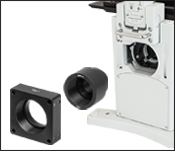
Click to Enlarge
Figure G1.1 Use the SM2Y1 epi-fluorescence port adapter with the LCP11(/M) cage plate to attach 60 mm cage systems.
The SM2Y1 port adapter connects to the epi-fluorescence port on certain Olympus IX71 microscopes. Figure G1.1 shows what an epi-fluorescence port of an Olympus IX71 microscope should look like for the SM2Y1 to be compatible. If the microscope does not appear as pictured, then the port adapter will not work. If you are unsure about compatibility, please contact Tech Support.
The SM2Y1 features internal SM2 threading on one side and internal SM30 threading on the other, allowing it be integrated into an externally SM2-threaded illumination source or Ø30 mm optic. One SM2RR retaining ring is provided with the SM2Y1 and can be used to secure a Ø2" optic up to 1.10" (28.0 mm) thick against the internal lip of the adapter; thicker retaining rings (Item # SM2RRC) are available for high-curvature lenses, though the curvature will limit the usable mounting depth. Please contact Tech Support to ensure a proper fit. The other side of the adapter can be used for Ø30 mm optics up to 1.09" (27.7 mm) thick using two SM30RR retaining rings, which are available for purchase separately.
Please note that the SM2Y1 adapter can be paired with the LCP11(/M) cage plate for 60 mm cage system compatibility. First attach the LCP11(/M) to the SM2 threads of the SM2Y1, then secure the connected adapters to the epi-fluorescence port by way of the circular dovetail on the SM2Y1 (see Figure G1.1 for alignment details). For 30 mm cage compatibility, consider using the CP38T cage plate; note that the cage plate will reduce the clear aperture.
Note: Thorlabs does not guarantee compatibility with other industry-standard microscopes not explicitly mentioned on this webpage.

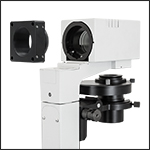
Click to Enlarge
Figure G2.1 Connecting the LCPY1(/M) to the Transmitted Illumination Port
These transmitted illumination port adapters provide compatibility for the Olympus BX41, BX51, IX71, IX73, IX81, and IX83 series microscopes with a range of Thorlabs' optomechanical products. The SM1A14B, SM2A7B, LED4A1, and SM2A13 adapters fit inside the trans-illumination port, while the LCPY1(/M) sits flush against the port. Two SM2RR retaining rings are provided with the LCPY1(/M) and can be used to secure Ø2" optics up to 1.24" (31.6 mm) thick within the optical path; other retaining rings are available for purchase separately, including thicker retaining rings for high-curvature lenses. The LCPY1/M features a small dimple indicating it is a metric part.
Note: Thorlabs does not guarantee compatibility with other industry-standard microscopes not explicitly mentioned on this webpage.

The SM1A51 is designed so that custom-built optical systems or detectors based on Thorlabs' components may be attached to the camera port of Olympus BX or IX Microscopes.
The SM1A51 features internal SM1 threading for Ø1" Lens Tubes and 4-40 tapped through holes on 30 mm centers for attaching cage rods. Our Scientific Cameras with internal C-mount threads can be adapted to SM1 threading using a C-Mount to SM1 adapter (Item # SM1A39), available separately. To achieve proper parfocality, we recommend using a Ø1" lens tube with 3" thread depth (Item # SM1L30) with the Olympus BX or IX microscopes and camera port adapters. In addition, an SM1-threaded dust cover (Item # SM1CP2) is included to keep the port closed when not in use.
Note: Thorlabs does not guarantee compatibility with other industry-standard microscopes not explicitly mentioned on this webpage.

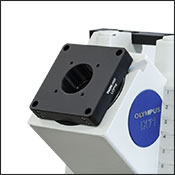
Click to Enlarge
Figure G4.1 LCPY2 Adapter Attached to Exposed Trinocular Port
The LCPY2 Trinocular Port Adapter allows custom widefield viewing setups to attach to an Olympus IX or BX Microscope. This adapter utilizes a male D5Y dovetail adapter to connect to the trinocular port of the microscope; see the Microscope Dovetails tab for details. This adapter can only be attached by first removing the microscope's trinoculars (see Figure G4.1).
This adapter features internal SM30 threading for Ø30 mm lens tubes; two SM30RR retaining rings are included to secure an optic inside the adapter. Through holes with side-located locking 8-32 setscrews (5/64" [2 mm] hex) can be used to attach Ø6 mm cage rods for 60 mm cage systems. The side opposite the dovetail has 4-40 tapped holes on 30 mm centers for compatibility with 30 mm cage systems.
Note: Thorlabs does not guarantee compatibility with other industry-standard microscopes not explicitly mentioned on this webpage.

Thorlabs offers two adapters that interface with Olympus trinoculars to incorporate them into custom microscope systems. The LCPN3 and LCPY3 Trinocular Adapters utilize a female D5Y dovetail to connect to an Olympus trinocular via a side-located M4 x 0.7 setscrew (5/64" [2 mm] hex). Please note that the trinoculars must be detached from the microscope itself prior to mounting these adapters.
The LCPN3 adapter features internal SM30 (M30.5 x 0.5) threading for Ø30 mm lens tubes, providing a clear aperture of Ø1.10" (Ø27.9 mm); two SM30RR retaining rings are included to secure an optic inside the adapter. A male D1N dovetail is included on the side opposite the female D5Y dovetail, allowing for integration with the trinocular port on an Upright Nikon Eclipse, Nikon Eclipse Ti, Nikon Eclipse Ti2, or Cerna Microscope. Four through holes, each with two side-located locking setscrews (5/64" [2 mm] hex), can be used to attach Ø6 mm cage rods for 60 mm cage systems.
The LCPY3 adapter is unthreaded with a clear aperture of Ø1.26" (32.0 mm). It features four through holes with side-located locking M4 x 0.7 setscrews (5/64" [2 mm] hex) that can be used to connect 60 mm cage systems and integrate into Cerna microscope systems. Additionally, the side opposite the dovetail has 4-40 tapped holes on 30 mm centers for compatibility with 30 mm cage systems.
Note: Thorlabs does not guarantee compatibility with other industry-standard microscopes not explicitly mentioned on this webpage.

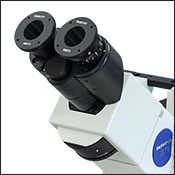
Click to Enlarge
Figure G6.1 Two SM2Y2 adapters replace the lens elements of the trinocular eyepieces.
The SM2Y2 Eyepiece Port Adapter allows custom-built optical detection systems to attach to the eyepieces on the trinoculars of an Olympus IX or BX Microscope. This adapter replaces the lens element on the eyepiece that sets the image plane focus at the the back of the eyes (see Figure G6.1). Because of the drop-in nature of the adapter, take care the attached system does not overbalance the 40 g eyepiece adapter when it is inside the trinoculars. Thorlabs recommends no more than 0.5 lbs at a distance of 5" from the adapter; the maximum torque to avoid rotation is 16.96 N•mm.
This adapter features 1.19" (30.2 mm) of internal SM1 threading for Ø1" lens tubes or optics, external SM2 threading for Ø2" lens tubes, and 4-40 tapped through holes on 30 mm centers for compatibility with a 30 mm cage system. The adapter includes two 0.08” thick SM1RR retaining rings to secure an optic inside the adapter.
Note: Thorlabs does not guarantee compatibility with other industry-standard microscopes not explicitly mentioned on this webpage.

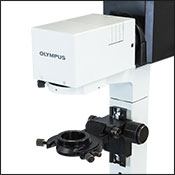
Click to Enlarge
Figure G7.2 SM2Y3 Adapter Attached to Condenser Holder of Olympus IX71
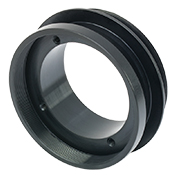
Click to Enlarge
Figure G7.1 The back of the SM2Y3 adapter has internal SM2 threads and 4-40 taps for 30 mm cage compatibility.
The SM2Y3 Condenser Port Adapter allows custom condenser configurations to attach to an Olympus IX or BX Microscope. The adapter utilizes a male D4Y dovetail to connect to the condenser holder of the microscope; see the Microscope Dovetails tab for details.
This adapter features internal and external SM2 threads for Ø2" lens tubes, achromatic doublets, or other optics as well as 4-40 tapped through holes on 30 mm centers for compatibility with a 30 mm cage system. One SM2RR retaining ring is included to secure a flat or mounted optic against the internal lip of the adapter, such as a filter or iris. The adapter lip limits the clear aperture to Ø1.5".
Note: Thorlabs does not guarantee compatibility with other industry-standard microscopes not explicitly mentioned on this webpage.
 Products Home
Products Home
























 Olympus BX and IX Microscope Port Adapters
Olympus BX and IX Microscope Port Adapters